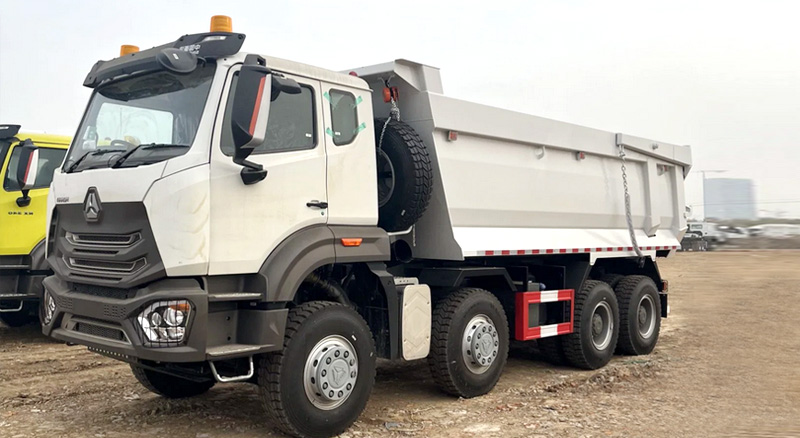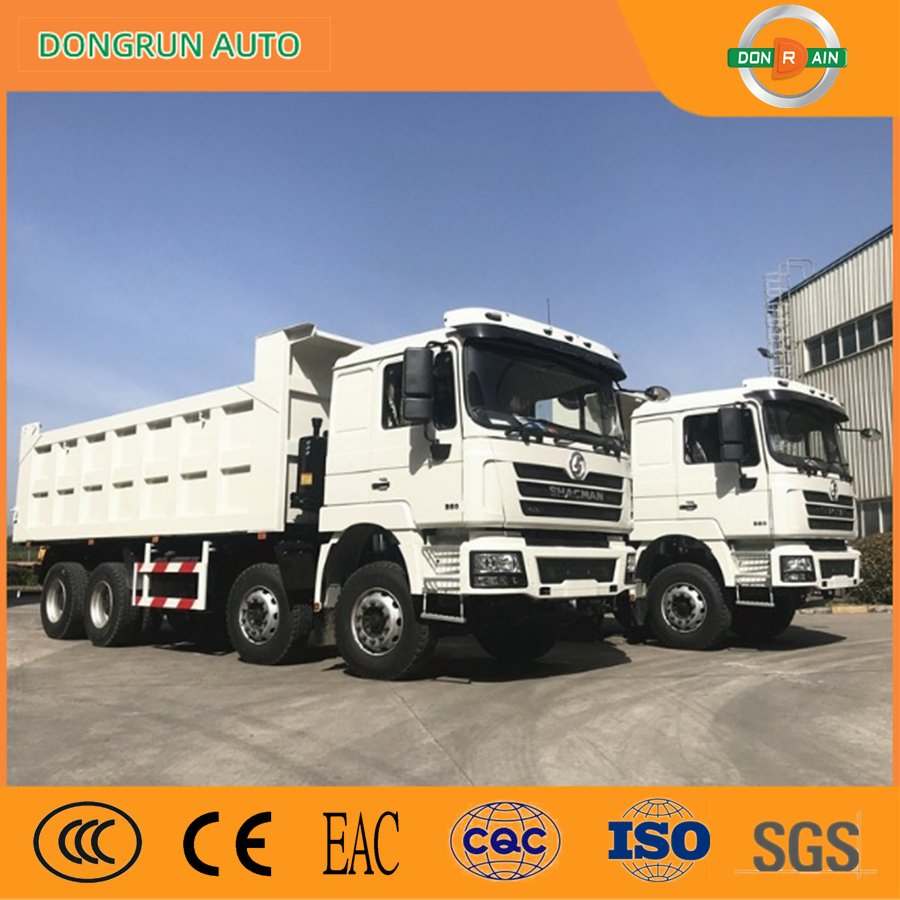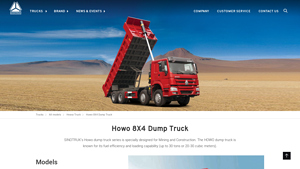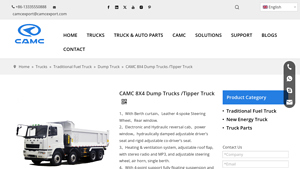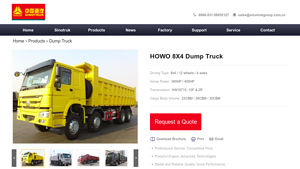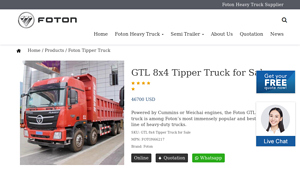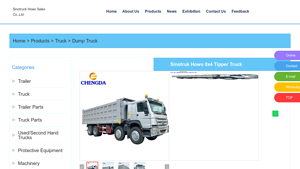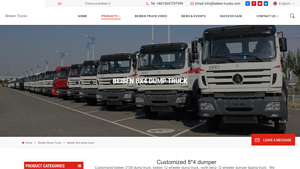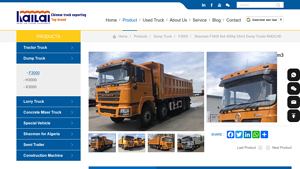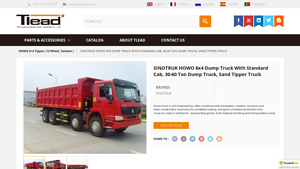Introduction: Navigating the Global Market for 8×4 Dump Tipper Truck
In the competitive landscape of heavy machinery, sourcing an 8×4 dump tipper truck that meets specific operational needs can be a daunting challenge for B2B buyers, particularly in regions like Africa, South America, the Middle East, and Europe. With varied applications ranging from construction to mining, the right dump truck must balance capacity, durability, and cost-effectiveness. This comprehensive guide aims to navigate the intricacies of the global market for 8×4 dump tipper trucks, addressing critical factors such as types, applications, supplier vetting processes, and pricing structures.
Buyers will gain insights into the specifications and performance capabilities of leading models, enabling them to make informed decisions that align with their unique operational requirements. We delve into the importance of supplier reliability, highlighting how to assess manufacturers based on quality, after-sales support, and compliance with international standards. Additionally, the guide will provide a comparative analysis of cost factors, empowering buyers to identify value-driven options without compromising on quality.
By equipping international B2B buyers with essential knowledge and actionable insights, this guide fosters confidence in the purchasing process, ensuring that businesses can optimize their investment in 8×4 dump tipper trucks for maximum productivity and efficiency. Whether you are looking to enhance your fleet or enter new markets, understanding these dynamics is crucial for sustainable growth and operational success.
Understanding 8×4 Dump Tipper Truck Types and Variations
| Type Name | Key Distinguishing Features | Primary B2B Applications | Brief Pros & Cons for Buyers |
|---|---|---|---|
| Standard 8×4 Dump Truck | High payload capacity (up to 30 tons), diesel engine, manual gearbox | Mining, construction, heavy material transport | Pros: High load capacity, fuel efficiency. Cons: May require specialized driver training. |
| Heavy-Duty 8×4 Tipper Truck | Enhanced suspension, higher torque (2000-2500 Nm), advanced braking systems | Infrastructure projects, waste management | Pros: Improved stability and safety. Cons: Higher initial purchase cost. |
| Multi-Functional 8×4 Dump Truck | Versatile usage with hydraulic lift, various cargo sizes, and configurations | General construction, agricultural transport | Pros: Flexible for different materials. Cons: Maintenance can be complex. |
| Eco-Friendly 8×4 Dump Truck | Complies with Euro 6 emission standards, optimized fuel consumption | Urban construction, green building projects | Pros: Lower emissions, potential tax incentives. Cons: Higher upfront costs compared to older models. |
| Customizable 8×4 Dump Truck | Tailored configurations for specific industries, various body types | Specialized transport (e.g., hazardous materials) | Pros: Meets unique business needs. Cons: Longer lead time for production. |
What Are the Characteristics of Standard 8×4 Dump Trucks?
Standard 8×4 dump trucks are characterized by their robust construction and high payload capacity, typically up to 30 tons. They are equipped with a diesel engine and a manual gearbox, making them ideal for heavy-duty tasks in mining and construction. B2B buyers should consider their fuel efficiency and reliability, which can significantly reduce operational costs in the long run. However, potential buyers must also account for the need for specialized driver training due to the truck’s size and handling requirements.
How Do Heavy-Duty 8×4 Tipper Trucks Stand Out?
Heavy-duty 8×4 tipper trucks are designed for demanding applications, featuring enhanced suspension systems and higher torque outputs ranging between 2000 to 2500 Nm. These trucks are particularly suitable for infrastructure projects and waste management due to their stability and advanced braking systems. While they offer improved safety and performance, B2B buyers should weigh the higher initial purchase cost against long-term benefits such as durability and reduced downtime.
What Makes Multi-Functional 8×4 Dump Trucks Versatile?
Multi-functional 8×4 dump trucks are designed for versatility, featuring hydraulic lifts and configurations that allow them to handle various cargo sizes and types. They are commonly used in general construction and agricultural transport, making them a valuable asset for companies with diverse operational needs. The flexibility of these trucks is a significant advantage, although buyers should be prepared for potentially complex maintenance due to their diverse functionalities.
Why Choose Eco-Friendly 8×4 Dump Trucks for Urban Projects?
Eco-friendly 8×4 dump trucks comply with Euro 6 emission standards and are optimized for fuel consumption, making them ideal for urban construction and green building projects. B2B buyers can benefit from lower emissions and may qualify for tax incentives, contributing to sustainability goals. However, the higher upfront costs associated with these models may deter some buyers, necessitating a careful evaluation of long-term savings and environmental impact.
How Do Customizable 8×4 Dump Trucks Cater to Specialized Needs?
Customizable 8×4 dump trucks can be tailored to meet the specific requirements of various industries, including those that transport hazardous materials. These trucks offer unique configurations and body types to suit specialized transport needs. While they provide a perfect fit for niche applications, B2B buyers should consider the longer lead time for production and the potential for increased costs associated with custom features.
Key Industrial Applications of 8×4 Dump Tipper Truck
| Industry/Sector | Specific Application of 8×4 Dump Tipper Truck | Value/Benefit for the Business | Key Sourcing Considerations for this Application |
|---|---|---|---|
| Construction | Transporting construction materials (sand, gravel) | Enhances project efficiency and reduces downtime | Load capacity, fuel efficiency, and durability in harsh conditions |
| Mining | Hauling ore and waste materials | Increases productivity and reduces operational costs | Engine power, emission standards, and maintenance support |
| Waste Management | Collecting and transporting waste | Improves waste management efficiency and compliance | Cargo capacity, hydraulic systems, and safety features |
| Agriculture | Moving soil, fertilizers, and crop residues | Streamlines agricultural operations and reduces labor | Versatility, payload capacity, and reliability |
| Infrastructure Development | Transporting materials for road and bridge projects | Supports timely project completion and reduces costs | Supplier reliability, parts availability, and after-sales service |
How is the 8×4 Dump Tipper Truck Used in the Construction Industry?
In the construction sector, the 8×4 dump tipper truck is primarily utilized for transporting essential materials such as sand, gravel, and asphalt. Its significant load capacity—typically between 25 to 30 tons—allows for fewer trips, significantly enhancing productivity and reducing project timelines. For international buyers, especially in regions like Africa and South America, sourcing trucks with robust engines that can withstand rough terrains and adverse weather conditions is crucial. Additionally, considerations regarding fuel efficiency can lead to substantial cost savings over the truck’s operational lifespan.
What Role Does the 8×4 Dump Tipper Truck Play in Mining Operations?
In mining, the 8×4 dump tipper truck excels at hauling both ore and waste materials from extraction sites to processing facilities. Its high payload capacity and powerful engine ensure that it can handle the demanding conditions typical of mining environments. Buyers from the Middle East and Europe should prioritize trucks that meet stringent emission standards while providing reliable maintenance support, as these factors can significantly impact operational efficiency and regulatory compliance. The durability and safety features of these trucks are also paramount to minimize downtime and enhance worker safety.
How is the 8×4 Dump Tipper Truck Beneficial for Waste Management?
The waste management industry benefits from the 8×4 dump tipper truck’s ability to collect and transport large volumes of waste efficiently. Equipped with hydraulic systems, these trucks facilitate quick unloading, which is critical in maintaining operational schedules. For B2B buyers in sectors focused on sustainability, choosing trucks with advanced safety features and cargo capacities that align with local regulations is essential. This ensures compliance with environmental standards while optimizing waste collection routes and reducing overall operational costs.
What is the Application of 8×4 Dump Tipper Truck in Agriculture?
In agriculture, the 8×4 dump tipper truck is used for moving soil, fertilizers, and crop residues, which is vital for efficient land management. The truck’s versatility allows it to adapt to various tasks, from transporting raw materials to facilitating the disposal of agricultural waste. Buyers should focus on trucks that offer a balance between payload capacity and ease of maneuverability in rural areas. Additionally, reliability and maintenance considerations are crucial for ensuring that agricultural operations are not disrupted during peak seasons.
How Does the 8×4 Dump Tipper Truck Support Infrastructure Development?
For infrastructure development projects, the 8×4 dump tipper truck is indispensable for transporting materials required for road and bridge construction. Its ability to handle heavy loads expedites project timelines and reduces costs associated with multiple trips. International buyers should consider sourcing trucks that are not only robust but also offer efficient fuel consumption and easy access to spare parts. This is particularly important in regions with challenging logistics, ensuring that projects remain on schedule and within budget.
3 Common User Pain Points for ‘8×4 Dump Tipper Truck’ & Their Solutions
Scenario 1: Struggling with Load Capacity Management
The Problem: Many B2B buyers in industries like construction and mining often face challenges related to load capacity management with their 8×4 dump tipper trucks. Overloading can lead to significant wear and tear on the vehicle, resulting in higher maintenance costs and potential safety risks. Moreover, underloading can diminish operational efficiency, leading to lost time and increased transportation costs. Buyers need to balance the truck’s capabilities with the actual loads they are moving, which can be a complex task in dynamic operational environments.
The Solution: To effectively manage load capacity, buyers should invest in training their operators on load distribution and vehicle limits. Understanding the truck’s specifications, including its maximum load capacity (up to 30 tons for many models), is crucial. Implementing a weight management system, such as onboard scales or monitoring software, can provide real-time feedback on load weights, ensuring optimal usage without exceeding limits. Additionally, buyers should consider periodic assessments of their loading practices to align with industry standards and regulations, thereby maximizing efficiency and safety in operations.
Scenario 2: Navigating Maintenance and Downtime Issues
The Problem: Maintenance and unexpected downtime are significant pain points for operators of 8×4 dump tipper trucks. Frequent breakdowns can disrupt projects, delay timelines, and lead to increased operational costs. Buyers often struggle to find reliable service providers or parts, especially in regions where access to quality support is limited. This uncertainty can deter them from making long-term investments in these vehicles.
The Solution: Establishing a proactive maintenance schedule is essential for minimizing downtime. Buyers should partner with manufacturers or trusted service centers that offer comprehensive maintenance packages tailored for 8×4 dump tipper trucks. This includes regular inspections, preventive maintenance, and quick access to genuine spare parts. Additionally, investing in training for in-house mechanics can empower companies to handle minor repairs promptly, reducing reliance on external services. Lastly, buyers should consider vehicles with robust after-sales support and warranty options, ensuring they have the backing needed to address maintenance issues swiftly.
Scenario 3: Ensuring Fuel Efficiency and Compliance
The Problem: Fuel efficiency is a critical concern for businesses operating 8×4 dump tipper trucks, especially in regions facing rising fuel costs and stringent environmental regulations. Buyers often find themselves grappling with balancing performance and compliance with emission standards. Trucks that consume excessive fuel or fail to meet regulations can lead to increased operational costs and potential legal issues, impacting the bottom line.
The Solution: To enhance fuel efficiency, buyers should focus on selecting models that feature advanced engine technology and optimal power output. For instance, trucks with engines rated at 336-420hp and compliant with EURO2-5 emissions standards typically offer better fuel economy. Implementing driver training programs that promote fuel-efficient driving techniques can further reduce consumption. Additionally, utilizing telematics systems to monitor fuel usage and vehicle performance allows companies to identify inefficiencies and make necessary adjustments. Regularly reviewing and optimizing routes can also contribute to lower fuel costs while ensuring compliance with local regulations. By taking these steps, businesses can achieve significant savings and enhance their sustainability efforts.
Strategic Material Selection Guide for 8×4 Dump Tipper Truck
What Are the Key Materials Used in 8×4 Dump Tipper Trucks?
When selecting materials for 8×4 dump tipper trucks, it is crucial to consider their performance characteristics, cost-effectiveness, and suitability for various applications. Below are some common materials used in the construction of these trucks, along with their properties, advantages, disadvantages, and considerations for international buyers.
1. High-Strength Steel
Key Properties: High-strength steel offers excellent tensile strength and durability, with a yield strength typically ranging from 350 to 700 MPa. It is also resistant to deformation under heavy loads, making it suitable for the demanding environments of mining and construction.
Pros & Cons: The main advantage of high-strength steel is its excellent strength-to-weight ratio, allowing for lighter truck designs without sacrificing performance. However, it can be more expensive than regular steel and may require specialized welding techniques, increasing manufacturing complexity.
Impact on Application: High-strength steel is ideal for truck frames and cargo beds, as it can withstand heavy loads and harsh conditions. Its compatibility with various coatings can enhance corrosion resistance, essential for trucks operating in humid or corrosive environments.
Considerations for International Buyers: Buyers should ensure compliance with international standards such as ASTM A572 or JIS G3106, which govern the quality and performance of high-strength steel. Understanding local regulations regarding material specifications is also critical.
2. Aluminum Alloys
Key Properties: Aluminum alloys are known for their lightweight nature and corrosion resistance. They typically have a density of about 2.7 g/cm³ and can withstand temperatures up to 600°C without significant deformation.
Pros & Cons: The primary advantage of aluminum alloys is their reduced weight, which can enhance fuel efficiency and payload capacity. However, they can be more expensive than steel and may not offer the same level of strength, making them less suitable for extremely heavy-duty applications.
Impact on Application: Aluminum is often used for components such as the truck body and fuel tanks, where weight savings are critical. Its corrosion resistance is beneficial for trucks operating in coastal or wet environments.
Considerations for International Buyers: Compliance with standards such as ASTM B209 for aluminum sheet and plate is essential. Buyers should also consider the availability of aluminum recycling facilities in their region, as this can impact long-term sustainability and cost.
3. Composite Materials
Key Properties: Composites, such as fiberglass-reinforced plastics, offer a unique combination of lightweight and high strength. They can withstand a wide range of temperatures and have excellent resistance to corrosion and chemicals.
Pros & Cons: Composites can significantly reduce the weight of truck components, improving fuel efficiency. However, they can be more expensive to manufacture and may require specialized handling and repair techniques.
Impact on Application: Composites are often used in non-structural components like interior panels and fairings, where weight savings and corrosion resistance are priorities. Their compatibility with various adhesives and coatings allows for versatile applications.
Considerations for International Buyers: Buyers should be aware of the specific manufacturing standards for composites, such as ASTM D638 for tensile properties. Understanding the local market for composite materials and their suppliers is crucial for ensuring quality and availability.
4. Rubber and Polymeric Materials
Key Properties: Rubber and polymeric materials are essential for components like tires, seals, and suspension systems. They provide excellent flexibility, shock absorption, and resistance to wear and tear.
Pros & Cons: The primary advantage of rubber is its ability to absorb shocks and vibrations, improving ride comfort and safety. However, it can degrade over time when exposed to UV light and extreme temperatures, necessitating regular maintenance and replacement.
Impact on Application: Rubber is critical for tires and suspension systems, impacting the overall performance and safety of the dump truck. The choice of rubber compounds can also affect traction and durability in various operating conditions.
Considerations for International Buyers: Buyers should consider the specific rubber grades and compounds that meet local regulations and performance standards. Understanding the lifecycle of rubber components can help in planning for maintenance and replacement schedules.
Summary Table of Material Selection for 8×4 Dump Tipper Trucks
| Material | Typical Use Case for 8×4 Dump Tipper Truck | Key Advantage | Key Disadvantage/Limitation | Relative Cost (Low/Med/High) |
|---|---|---|---|---|
| High-Strength Steel | Truck frames, cargo beds | Excellent strength-to-weight ratio | Higher cost, complex manufacturing | Medium |
| Aluminum Alloys | Truck body, fuel tanks | Lightweight, corrosion-resistant | Expensive, lower strength than steel | High |
| Composite Materials | Interior panels, fairings | Lightweight, corrosion-resistant | High manufacturing cost, specialized repair | High |
| Rubber/Polymeric | Tires, seals, suspension systems | Shock absorption, flexibility | Degrades over time, requires maintenance | Medium |
This guide aims to provide B2B buyers with actionable insights into material selection for 8×4 dump tipper trucks, ensuring that they make informed decisions that align with their operational needs and regional standards.
In-depth Look: Manufacturing Processes and Quality Assurance for 8×4 Dump Tipper Truck
What Are the Main Stages in the Manufacturing Process of 8×4 Dump Tipper Trucks?
The manufacturing process of 8×4 dump tipper trucks involves several key stages that ensure the final product meets both performance and quality standards. These stages typically include material preparation, forming, assembly, and finishing.
-
Material Preparation: The process begins with selecting high-quality raw materials, primarily high-strength steel for the chassis and cargo body. Suppliers often provide materials that conform to international standards, ensuring durability and performance. Rigorous material testing, including tensile strength and hardness tests, is conducted to verify that the materials meet specifications.
-
Forming: This stage involves shaping the raw materials into the required components using various techniques such as stamping, welding, and machining. Advanced technologies like CNC (Computer Numerical Control) machines are employed for precision cutting and shaping of parts. For the cargo body, a one-time formed high-strength steel sheet is used to enhance structural integrity and reduce material wastage.
-
Assembly: Once the components are formed, they are assembled into the truck’s structure. This stage includes the installation of the engine, transmission, suspension systems, and the cargo bed. Automated assembly lines, equipped with robotics, may be used to ensure consistency and efficiency. Quality checks are performed at various points during assembly to identify any defects early in the process.
-
Finishing: The final stage involves painting and coating the truck to protect against corrosion and environmental factors. A multi-layer paint system is typically applied, which includes primers, base coats, and clear coats. This not only enhances aesthetic appeal but also increases longevity. Post-paint inspections are crucial to ensure a flawless finish.
How Is Quality Assurance Integrated into the Manufacturing Process of 8×4 Dump Tipper Trucks?
Quality assurance (QA) is an integral part of the manufacturing process for 8×4 dump tipper trucks, ensuring that each vehicle meets international standards and customer expectations. Key elements of QA include adherence to relevant standards, systematic checkpoints, and robust testing methodologies.
-
International and Industry-Specific Standards: Manufacturers typically adhere to ISO 9001 for quality management systems, ensuring consistent quality in their processes. Additionally, industry-specific certifications like CE (European Conformity) and API (American Petroleum Institute) may be applicable, particularly for trucks designed for specialized uses such as mining and construction.
-
Quality Control Checkpoints: Quality control (QC) checkpoints are established at various stages of the manufacturing process, including:
– Incoming Quality Control (IQC): This involves inspecting raw materials and components upon arrival at the manufacturing facility to ensure they meet specified standards.
– In-Process Quality Control (IPQC): Throughout the assembly process, operators conduct inspections to verify that each component is assembled correctly and functions as intended.
– Final Quality Control (FQC): After assembly, a comprehensive inspection is performed, including functionality tests, to ensure the truck is ready for delivery. -
Common Testing Methods: Various testing methods are employed to validate the quality of the 8×4 dump tipper trucks. These may include:
– Performance Testing: Assessing the truck’s load capacity, fuel efficiency, and handling characteristics.
– Durability Testing: Subjecting the truck to extreme conditions to evaluate its resilience under stress.
– Safety Testing: Ensuring that all safety features, such as brakes and stability controls, function correctly.
How Can B2B Buyers Verify the Quality Control Measures of Suppliers?
For international B2B buyers, particularly those from Africa, South America, the Middle East, and Europe, verifying the quality control measures of suppliers is crucial to ensure they receive a reliable product. Here are several strategies to achieve this:
-
Conducting Supplier Audits: Buyers can perform on-site audits of manufacturing facilities to assess the quality management systems in place. This includes reviewing documentation related to quality assurance processes, employee training, and production practices.
-
Requesting Quality Control Reports: Suppliers should be willing to provide detailed reports outlining their quality control processes, results from testing, and compliance with international standards. Reviewing these documents helps buyers understand the supplier’s commitment to quality.
-
Engaging Third-Party Inspection Services: Independent third-party inspectors can be hired to conduct inspections at various stages of the manufacturing process. These inspectors can provide unbiased assessments of the quality standards being followed, offering buyers additional peace of mind.
What Are the Quality Control and Certification Nuances for International B2B Buyers?
When navigating the purchase of 8×4 dump tipper trucks, international B2B buyers must be aware of specific quality control and certification nuances that may affect their procurement strategy.
-
Regional Standards Compliance: Different regions may have varying standards for emissions, safety, and performance. Buyers should ensure that the trucks comply with local regulations, such as Euro emissions standards in Europe or specific certifications required in African countries.
-
Understanding Warranty and After-Sales Support: Quality assurance extends beyond the manufacturing process. Buyers should inquire about warranty terms and after-sales support, including the availability of spare parts and service networks. A robust after-sales support system is a critical indicator of a supplier’s confidence in their product quality.
-
Cultural and Market Considerations: Buyers from different regions may face unique challenges related to quality assurance. Understanding local market dynamics, cultural expectations, and logistical considerations can enhance the overall procurement process and ensure that the quality of the product aligns with regional needs.
By focusing on these aspects of manufacturing processes and quality assurance, B2B buyers can make informed decisions when sourcing 8×4 dump tipper trucks, ultimately leading to successful partnerships and operational efficiency.
Practical Sourcing Guide: A Step-by-Step Checklist for ‘8×4 Dump Tipper Truck’
Introduction
Sourcing an 8×4 dump tipper truck requires careful consideration and a structured approach to ensure that the selected vehicle meets your operational needs. This guide provides a step-by-step checklist designed for international B2B buyers, particularly in regions like Africa, South America, the Middle East, and Europe. By following these steps, you can streamline the procurement process and make informed decisions.
Step 1: Define Your Technical Specifications
Establishing clear technical specifications is crucial for selecting the right 8×4 dump tipper truck. Consider factors such as load capacity, engine power, and dimensions, which will directly impact performance in your specific applications, such as construction or mining.
- Load Capacity: Aim for a truck that can handle the maximum load you anticipate, typically between 25 to 40 tons.
- Engine Power: Choose an engine within the range of 336-420 hp to ensure adequate performance.
Step 2: Research Market Options
Conduct thorough market research to identify potential suppliers and models that fit your specifications. Analyze the performance, reliability, and customer reviews of various brands, such as Howo and CAMC, to determine which trucks are favored in your target market.
- Brand Reputation: Look for brands known for durability and fuel efficiency.
- Model Comparisons: Compare different models to understand the features and benefits each offers.
Step 3: Evaluate Potential Suppliers
Before committing to a purchase, it’s vital to vet potential suppliers comprehensively. Request detailed company profiles, case studies, and references from other buyers in similar industries or regions to gauge their reliability.
- Supplier Experience: Assess how long the supplier has been in the industry and their track record with similar products.
- Client Feedback: Reach out to previous clients to understand their experiences regarding quality and after-sales service.
Step 4: Verify Compliance with Standards
Ensure that the trucks comply with relevant emissions and safety standards applicable in your region. This is particularly important in areas with strict regulations, as non-compliance can lead to legal issues and operational setbacks.
- Emission Standards: Check for compliance with EURO 2-6 emissions standards.
- Safety Certifications: Look for trucks equipped with advanced safety features like ABS and electronic stability control.
Step 5: Assess After-Sales Support and Warranty
After-sales support is a key factor in ensuring the longevity and performance of your investment. Investigate the warranty offered by the supplier and the availability of spare parts and service support.
- Warranty Terms: Review the duration and coverage of the warranty to protect your investment.
- Parts Availability: Confirm that spare parts are easily accessible, which is crucial for minimizing downtime.
Step 6: Request Quotes and Compare Pricing
Once you have narrowed down your options, request detailed quotes from multiple suppliers. This will allow you to compare pricing, payment terms, and included services.
- Transparent Pricing: Ensure that quotes include all costs, such as delivery and customs duties.
- Negotiation: Use the information from various quotes to negotiate better terms or discounts.
Step 7: Finalize the Purchase and Logistics
After selecting the best supplier and finalizing the terms, arrange for logistics to ensure the timely delivery of your dump tipper truck. Coordinate with the supplier to handle shipping and customs clearance.
- Shipping Arrangements: Confirm the delivery timeline and shipping method.
- Documentation: Ensure all necessary paperwork, including import permits and customs documentation, is in order for a smooth transaction.
By following this checklist, B2B buyers can ensure a thorough and efficient procurement process for 8×4 dump tipper trucks, tailored to meet their operational needs.
Comprehensive Cost and Pricing Analysis for 8×4 Dump Tipper Truck Sourcing
What Are the Key Cost Components in 8×4 Dump Tipper Truck Manufacturing?
When sourcing 8×4 dump tipper trucks, understanding the cost structure is crucial for buyers looking to negotiate favorable terms. The primary cost components include:
-
Materials: The selection of high-strength steel and advanced composites significantly influences the overall material cost. Trucks designed for heavy-duty applications, such as mining and construction, require robust materials to ensure durability and safety.
-
Labor: Labor costs can vary depending on the manufacturing location. Skilled labor in regions with higher wage standards will increase production costs, whereas lower-wage countries may offer cost advantages.
-
Manufacturing Overhead: This includes utilities, rent, and equipment depreciation. Companies with efficient production processes can minimize these costs, impacting the final price.
-
Tooling: Initial tooling costs can be substantial, especially for custom designs. However, these costs can be amortized over large production runs, making higher volumes more cost-effective.
-
Quality Control (QC): Investing in rigorous QC processes ensures reliability and compliance with international standards, which can add to the upfront costs but reduces long-term risks.
-
Logistics: Transportation costs depend on the distance to the buyer, shipping method, and any import duties. Buyers should consider local availability versus overseas sourcing.
-
Margin: Manufacturer profit margins vary based on market competition and the perceived value of the truck’s brand and features.
How Do Pricing Influencers Affect 8×4 Dump Tipper Truck Costs?
Several factors can influence the pricing of 8×4 dump tipper trucks:
-
Volume and Minimum Order Quantity (MOQ): Bulk purchases often come with discounts. Understanding a supplier’s MOQ can help buyers plan their acquisitions more strategically.
-
Specifications and Customization: Customized trucks tailored for specific applications may incur additional costs. Buyers should weigh the benefits of customization against the added expense.
-
Materials and Quality Certifications: Trucks that meet higher emission standards or possess advanced safety features typically command higher prices. Buyers should assess the importance of these certifications based on their operational needs.
-
Supplier Factors: The reputation and reliability of the supplier can impact pricing. Established brands may charge a premium for their name and proven performance.
-
Incoterms: Familiarity with Incoterms is vital for understanding who bears the risk and cost at various stages of the shipping process. This can significantly affect the total landed cost of the truck.
What Negotiation Strategies Can B2B Buyers Employ When Sourcing Dump Tipper Trucks?
Effective negotiation is key to achieving favorable pricing. Here are several strategies for B2B buyers:
-
Leverage Volume Discounts: If you can commit to a larger order, negotiate for a better price per unit. Suppliers often prefer bulk orders as they reduce their per-unit production costs.
-
Request Multiple Quotes: Gather quotes from different suppliers to create a competitive environment, which can drive down prices.
-
Explore Payment Terms: Discuss flexible payment terms or financing options that may ease cash flow concerns while still securing the desired pricing.
-
Focus on Total Cost of Ownership (TCO): Highlight the long-term savings from fuel efficiency, maintenance, and reliability when discussing prices. This perspective can justify a higher upfront cost if the TCO is lower.
What Pricing Nuances Should International Buyers Be Aware Of?
For international buyers, particularly in regions like Africa, South America, the Middle East, and Europe, several nuances can affect pricing:
-
Currency Fluctuations: Exchange rates can impact the final cost. Buyers should consider locking in prices when rates are favorable.
-
Import Duties and Taxes: Understanding local regulations regarding import duties can help in calculating the total cost accurately.
-
Cultural Differences in Negotiation: Be aware of different negotiation styles and practices in various cultures, which can affect the buying process.
Disclaimer on Pricing Information
Prices for 8×4 dump tipper trucks can vary widely based on specifications, supplier relationships, and market conditions. The figures mentioned are indicative and should be confirmed with suppliers for accuracy. Always conduct thorough due diligence to ensure the best procurement decisions.
Alternatives Analysis: Comparing 8×4 Dump Tipper Truck With Other Solutions
Exploring Alternative Solutions to the 8×4 Dump Tipper Truck
When evaluating heavy-duty transportation options, it is essential to consider various alternatives to the 8×4 Dump Tipper Truck. This section compares the 8×4 Dump Tipper Truck with two viable alternatives: the 6×4 Dump Truck and the articulated dump truck (ADT). Each option presents unique advantages and disadvantages depending on the specific needs of a construction or mining project.
| Comparison Aspect | 8X4 Dump Tipper Truck | 6×4 Dump Truck | Articulated Dump Truck (ADT) |
|---|---|---|---|
| Performance | High load capacity (up to 30 tons) and stability for rough terrain. | Moderate load capacity (up to 25 tons), good for lighter materials. | Excellent off-road capability with flexibility in maneuvering. |
| Cost | Higher initial investment, but lower operating costs due to fuel efficiency. | Generally lower upfront cost, but higher long-term maintenance expenses. | Higher purchase price, but offers versatility and efficiency in challenging terrains. |
| Ease of Implementation | Requires experienced operators and maintenance due to size. | Easier to operate; more common in urban settings. | Requires specialized training for operators. |
| Maintenance | Regular service required; parts readily available. | Lower maintenance frequency, but parts can be costly. | Higher maintenance costs due to complex drivetrain. |
| Best Use Case | Ideal for heavy construction and mining operations needing high load capacity. | Suitable for urban construction projects with lighter materials. | Best for rugged terrains where maneuverability is crucial. |
Detailed Breakdown of Alternatives
6×4 Dump Truck
The 6×4 Dump Truck serves as a more economical option for businesses that do not require the heavy lifting capabilities of an 8×4 model. With a lower initial investment, it can be a suitable choice for urban projects where maneuverability is essential. However, it offers a reduced load capacity, making it less effective for heavy-duty tasks. Maintenance costs can add up, particularly if parts are not readily available.
Articulated Dump Truck (ADT)
Articulated Dump Trucks are designed for challenging terrains, offering unparalleled maneuverability and flexibility. Their unique design allows for effective load distribution, making them ideal for off-road applications. However, they come with a higher price tag and require specialized operator training. While they excel in rough conditions, the cost of ownership can be significant due to their complex mechanical systems.
Making the Right Choice for Your Needs
When choosing between an 8×4 Dump Tipper Truck and its alternatives, B2B buyers must consider specific project requirements, including load capacity, terrain type, and budget constraints. The 8×4 model is particularly advantageous for heavy-duty applications, while the 6×4 Dump Truck offers a more economical solution for lighter loads. On the other hand, the Articulated Dump Truck shines in challenging environments but at a higher cost. Evaluating these factors will enable buyers to select the most suitable option for their operational needs, ensuring efficiency and productivity in their projects.
Essential Technical Properties and Trade Terminology for 8×4 Dump Tipper Truck
What Are the Essential Technical Properties of an 8×4 Dump Tipper Truck?
When considering the purchase of an 8×4 dump tipper truck, understanding its technical specifications is crucial for making informed decisions. Here are some key properties to evaluate:
-
Payload Capacity
The payload capacity typically ranges from 25 to 40 tons, depending on the model. This specification is critical for B2B buyers as it directly impacts operational efficiency and cost-effectiveness. A higher payload capacity means fewer trips are needed to transport materials, which can significantly reduce fuel and labor costs. -
Engine Power and Emission Standards
Engine power generally falls between 336 and 420 horsepower, with emission standards compliant with Euro 2 to Euro 6 regulations. Understanding the engine’s power is essential for assessing the truck’s performance in heavy-duty applications, such as mining and construction. Compliance with emission standards is increasingly important in global markets, reflecting a commitment to sustainability and regulatory adherence. -
Wheel Configuration and Dimensions
The 8×4 configuration refers to the truck having eight wheels, with four being driven. Typical dimensions are approximately 10,245 mm in length and 2,496 mm in width. Knowing the wheel configuration helps buyers understand the truck’s stability and maneuverability, which are vital for navigating challenging terrains, especially in construction and mining environments. -
Transmission and Gear Ratio
Most 8×4 dump trucks come with a manual transmission featuring around 10 forward gears. The gear ratio affects the truck’s acceleration and fuel efficiency. B2B buyers should consider the transmission type as it influences the vehicle’s adaptability to various load conditions and driving environments. -
Cargo Body Material and Design
The cargo body is usually made from high-strength steel to ensure durability and efficiency in material handling. A well-designed cargo body allows for smooth material dumping and minimizes residue, which is crucial for operational efficiency. Buyers should prioritize trucks with advanced cargo designs to enhance productivity. -
Safety Features
Advanced safety features, such as Anti-lock Braking Systems (ABS) and Electronic Stability Control (ESC), are essential for ensuring driver and material safety. Understanding these features helps buyers mitigate risks associated with heavy load transportation, especially in hazardous environments.
What Are Common Trade Terms in the 8×4 Dump Truck Industry?
Navigating the B2B landscape involves familiarizing oneself with specific trade terminology. Here are some key terms relevant to 8×4 dump tipper trucks:
-
OEM (Original Equipment Manufacturer)
This term refers to the company that produces the truck’s original components. Understanding OEM relationships is important for buyers seeking high-quality parts and reliable service. -
MOQ (Minimum Order Quantity)
MOQ signifies the smallest number of units a supplier is willing to sell. For B2B buyers, knowing the MOQ is vital for planning purchases, especially if bulk buying is required for projects. -
RFQ (Request for Quotation)
An RFQ is a formal document requesting pricing and terms from suppliers. Issuing an RFQ helps businesses compare offers from different manufacturers and negotiate better deals. -
Incoterms (International Commercial Terms)
These are standardized trade terms that define the responsibilities of buyers and sellers in international transactions. Familiarity with Incoterms is essential for understanding shipping costs, insurance, and delivery responsibilities. -
Tare Weight
Tare weight refers to the truck’s weight without any cargo. Knowing this helps buyers calculate the net payload capacity, which is crucial for compliance with weight regulations. -
Lead Time
This term describes the time taken from placing an order to delivery. Understanding lead time is critical for project planning and ensuring that equipment is available when needed.
By grasping these technical properties and trade terms, B2B buyers can make more informed decisions when procuring 8×4 dump tipper trucks, enhancing operational efficiency and ensuring compliance with industry standards.
Navigating Market Dynamics and Sourcing Trends in the 8×4 Dump Tipper Truck Sector
What Are the Current Trends Shaping the Global 8×4 Dump Tipper Truck Market?
The global market for 8×4 dump tipper trucks is witnessing significant transformation, driven by factors such as rapid urbanization, infrastructure development, and the increasing demand for efficient transportation solutions in sectors like mining and construction. As economies in Africa, South America, the Middle East, and Europe continue to grow, there is a heightened need for robust vehicles capable of handling heavy loads in challenging terrains. The emphasis on fuel efficiency and reduced operational costs has also led to innovations in engine technology, with manufacturers focusing on models that adhere to stringent emission standards, ranging from EURO 2 to EURO 6.
Emerging B2B technologies are reshaping sourcing trends as well. The integration of telematics systems allows fleet managers to monitor vehicle performance in real-time, optimizing maintenance schedules and reducing downtime. Additionally, digital platforms are enhancing procurement processes, enabling international buyers to compare specifications, prices, and suppliers easily. This digitalization fosters transparency, aiding buyers in making informed decisions while also ensuring a competitive edge in pricing.
How Is Sustainability Influencing Sourcing Decisions in the 8×4 Dump Tipper Truck Sector?
Sustainability has become a cornerstone of sourcing strategies in the 8×4 dump tipper truck sector. Environmental concerns are prompting companies to evaluate the ecological impact of their supply chains. Buyers are increasingly prioritizing manufacturers that employ sustainable practices, such as using recycled materials or adopting energy-efficient production methods. Certifications such as ISO 14001 for environmental management systems are becoming essential for suppliers seeking to establish credibility in the market.
Moreover, the transition to ‘green’ technologies is gaining momentum. Manufacturers are exploring alternative fuel sources, including electric and hybrid models, to meet the demands of eco-conscious buyers. The use of lightweight materials, which enhance fuel efficiency while maintaining structural integrity, is also on the rise. For international B2B buyers, partnering with suppliers committed to sustainability not only fulfills regulatory requirements but also strengthens brand reputation in an increasingly eco-aware marketplace.
What Historical Developments Have Shaped the 8×4 Dump Tipper Truck Market?
The evolution of the 8×4 dump tipper truck can be traced back to the early 20th century when trucks began to replace horse-drawn vehicles in construction and mining. Over the decades, advancements in engineering and materials science have revolutionized design and performance. The introduction of hydraulic lifting mechanisms in the mid-1900s significantly improved the efficiency of loading and unloading materials.
In recent years, the focus has shifted towards enhancing driver safety and comfort, with features like advanced braking systems, ergonomic cab designs, and integrated technology for navigation and diagnostics. This evolution reflects a broader trend within the automotive industry towards greater automation and connectivity, aligning with the needs of modern logistics and construction operations. Understanding these historical shifts is crucial for B2B buyers as they navigate the complexities of sourcing vehicles that meet both current demands and future challenges.
Frequently Asked Questions (FAQs) for B2B Buyers of 8×4 Dump Tipper Truck
-
How do I choose the right 8×4 dump tipper truck for my business needs?
Choosing the right 8×4 dump tipper truck involves assessing your specific operational requirements. Consider the payload capacity, which typically ranges from 25 to 30 tons, and the engine power, usually between 336 and 420 horsepower. Evaluate the truck’s dimensions to ensure it fits your site conditions and check for compliance with local emission standards (EURO2-5). Additionally, assess the truck’s durability and fuel efficiency, particularly if you operate in demanding environments like construction or mining. -
What are the common applications for 8×4 dump tipper trucks?
8×4 dump tipper trucks are primarily used in construction, mining, and heavy-duty transport. Their robust design makes them suitable for hauling materials such as sand, gravel, and demolition debris. They are also effective in waste management and agricultural applications. Understanding the specific requirements of your industry can help you select the right model, ensuring that it meets both performance and regulatory standards. -
What should I consider when vetting suppliers for 8×4 dump tipper trucks?
When vetting suppliers, assess their reputation and experience in the market. Look for suppliers with a proven track record in manufacturing or exporting 8×4 dump tipper trucks, especially those who cater to your region. Verify their certifications and compliance with international quality standards. Additionally, request references from previous clients to gauge customer satisfaction and the reliability of their after-sales support, including maintenance and spare parts availability. -
What are the typical minimum order quantities (MOQ) for 8×4 dump tipper trucks?
The minimum order quantity for 8×4 dump tipper trucks can vary significantly depending on the manufacturer and your negotiation capabilities. Many manufacturers may require a MOQ of 5 to 10 units to ensure cost-effectiveness and production efficiency. However, smaller orders may be possible with certain suppliers, especially if you are willing to pay a premium. Always discuss MOQs upfront to avoid any misunderstandings during the purchasing process. -
What payment terms should I expect when purchasing 8×4 dump tipper trucks?
Payment terms can vary widely among suppliers. Generally, expect to pay a deposit (usually 20-30%) upon order confirmation, with the balance due before shipment or upon delivery. Some suppliers may offer financing options or flexible payment plans, particularly for larger orders. Ensure that all payment terms are clearly outlined in your contract to protect your interests and facilitate a smooth transaction. -
How can I ensure the quality of 8×4 dump tipper trucks before purchasing?
To ensure quality, request detailed specifications and certifications from the supplier. Consider arranging a factory visit to inspect the manufacturing process and quality control measures firsthand. Ask for samples or detailed photographs of previous builds, and inquire about warranty terms and after-sales support. Engaging a third-party inspection service can also provide an unbiased assessment of the truck’s quality before finalizing your purchase. -
What logistics considerations should I keep in mind when importing 8×4 dump tipper trucks?
Logistics play a critical role in the successful import of 8×4 dump tipper trucks. Consider the shipping method (e.g., container shipping vs. roll-on/roll-off), as well as the associated costs and transit times. Ensure compliance with local customs regulations and prepare necessary documentation, such as bills of lading and import permits. Collaborating with a freight forwarder experienced in heavy equipment can streamline the process and minimize delays. -
What are the common maintenance practices for 8×4 dump tipper trucks?
Regular maintenance is essential for the longevity and performance of 8×4 dump tipper trucks. Key practices include routine inspections of the engine, brakes, and tires, as well as checking hydraulic systems and the cargo box for wear and tear. Establish a maintenance schedule based on usage frequency, and ensure that all service records are kept updated. Engaging certified technicians for repairs and using genuine spare parts can help maintain the truck’s reliability and safety.
Important Disclaimer & Terms of Use
⚠️ Important Disclaimer
The information provided in this guide, including content regarding manufacturers, technical specifications, and market analysis, is for informational and educational purposes only. It does not constitute professional procurement advice, financial advice, or legal advice.
While we have made every effort to ensure the accuracy and timeliness of the information, we are not responsible for any errors, omissions, or outdated information. Market conditions, company details, and technical standards are subject to change.
B2B buyers must conduct their own independent and thorough due diligence before making any purchasing decisions. This includes contacting suppliers directly, verifying certifications, requesting samples, and seeking professional consultation. The risk of relying on any information in this guide is borne solely by the reader.
Top 8 8X4 Dump Tipper Truck Manufacturers & Suppliers List
1. SINOTRUK – Howo 8X4 Dump Truck
Domain: howo-truck.com
Registered: 2009 (16 years)
Introduction: {“model”:”Howo 8X4 Dump Truck”,”manufacturer”:”SINOTRUK”,”application”:”Mining and Construction”,”fuel_efficiency”:”Yes”,”loading_capacity”:”up to 30 tons or 20-30 cubic meters”,”drive_type”:”8×4″,”dimensions”:”10245×2496×3400 mm”,”max_load”:”30000 kg”,”emission_standards”:”EURO2-5″,”engine_power”:”336-420 hp”,”number_of_tires”:”12 wheels”,”curb_weight”:”14860 kg”,”gearbox_model”:”HW19710″,”gearbo…
2. CAMC – 8X4 Dump Trucks
Domain: camcexport.com
Registered: 2021 (4 years)
Introduction: {“Product Name”: “CAMC 8X4 Dump Trucks / Tipper Truck”, “Horsepower”: “420hp”, “Emission Standard”: “Euro 2-6”, “Transmission Type”: “Manual”, “Forward Shift Number”: “9”, “Reverse Shift Number”: “1”, “Maximum Torque (Nm)”: “2000-2500Nm”, “Dimensions (L x W x H) (mm)”: “10080*2495*3600mm”, “Cargo Tank Dimension”: “5600*2350*1500mm”, “Cargo Tank Length”: “5.3-6.2M”, “Gross Vehicle Weight”: “25-30T,…
3. SINOTRUK – HOWO 8X4 DUMP TRUCK
Domain: sinotrukgroup.com.cn
Registered: 2016 (9 years)
Introduction: {“Product Name”: “SINOTRUK HOWO 8X4 DUMP TRUCK”, “Driving Type”: “8×4 / 12 wheels / 4 axles”, “Horse Power”: “380HP / 400HP”, “Transmission”: “HW19710, 10F & 2R”, “Cargo Body Volume”: “22CBM / 26CBM / 30CBM”, “Chassis Model”: “ZZ3317V3567B1”, “Driving Type”: “LHD (RHD is optional)”, “Cabin”: “HW76, with one sleeper and two seats, double arm windscreen wiper system with three speeds, damped adjusta…
4. Foton – Auman GTL 8×4 Tipper Truck
Domain: foton-auman.com
Registered: 2022 (3 years)
Introduction: Foton Auman GTL 8×4 Tipper Truck for Sale
Price: 46700 USD
Engine Options: Cummins or Weichai
Drive Type: 8×4
Wheel Base: 1800+4700+1350 mm
Overall Dimensions: 11460*2495*3580 mm
Curb Weight: 15385 Kg
Load Capacity: 40000 Kg
Cabin: Flat roof, one and half rows, luxury configuration, 2 passengers allowable, with single bunker, A/C
Engine Model: ISGe5-400
Max Output: 294 kW / 400 HP
Max Torque: 2100…
5. Sinotruk – Howo 8×4 Tipper Truck
Domain: cdtruck.com
Registered: 2017 (8 years)
Introduction: Sinotruk Howo 8×4 Tipper Truck
– Designed for loads: sand, stone, ore, mineral powder, iron powder, construction slag
– Characteristics: reliable power, efficient transportation, high bearing capacity, high reliability, high safety, high economy
– Specifications:
– Drive System: LHD/RHD
– Cabin: F2000 flat Cabin, one sleeper, Air Conditioner
– Engine Brand: WEICHAI
– Engine Model: WD615.50…
6. Beiben – 8×4 Dump Truck
Domain: beiben-trucks.com
Registered: 2014 (11 years)
Introduction: Model: Beiben 8×4 Dump Truck
Variants: 3134, 3142, 3138
Engine Models: WP10.380, WP12.420
Engine Power: 380 hp, 420 hp
Wheelbase: 1500+3550+1450, 1500+4150+1450, 1950+4450+1450
Payload Capacity: 80 T, 90 T, 100 T
Applications: Construction, Mining, Agriculture
Manufacturer: Beiben Trucks
Experience: 20 years in production and exporting
7. Shacman – F3000 8×4 Dump Truck
Domain: shacman.org.cn
Registered: 2012 (13 years)
Introduction: Brand: Shacman
Model: F3000 8×4 Dump Truck
Configuration: 12 Wheels
Engine Power: 400HP
Cargo Capacity: 30 cubic yard (25CBM)
Driving Type: RHD/LHD
Engine Brand: Weichai Diesel
Engine Type: 4 stroke direct injection diesel engine, 6 cylinder in-line, turbo-charging & inter cooling
Engine Model: WP1 2.400 E 201 Euro II
Maximum Output: 400HP
Rated Speed: 1900rpm
Max Torque: 1920N.m (1000-1400rpm)
Di…
8. SINOTRUK – HOWO 8×4 Dump Truck
Domain: topleadzzl.com
Registered: 2014 (11 years)
Introduction: Brand: SINOTRUK
Model: HOWO 8×4 Dump Truck
Type: Standard Cab, 30-60 Ton Dump Truck, Sand Tipper Truck
Usage: Suitable for civil engineering, earthwork, transporting gravel, bulk material handling, and transportation work.
Features: 12 Wheel, Tandem, often combined with excavators, loaders, conveyor, and other construction machinery.
Strategic Sourcing Conclusion and Outlook for 8×4 Dump Tipper Truck
In conclusion, the strategic sourcing of 8×4 dump tipper trucks presents significant opportunities for international buyers seeking reliable, high-capacity vehicles for construction and mining applications. With loading capabilities ranging from 25 to 40 tons and advanced features such as fuel efficiency, safety systems, and robust build quality, these trucks are designed to meet the demanding needs of various industries. Buyers should prioritize suppliers that offer comprehensive after-sales support, including spare parts availability and maintenance services, ensuring long-term operational efficiency.
As we look to the future, the demand for durable and efficient dump trucks is expected to grow, particularly in emerging markets across Africa, South America, the Middle East, and Europe. By leveraging strategic sourcing practices, businesses can optimize their procurement processes, reduce costs, and enhance their supply chain resilience.
Now is the ideal time for B2B buyers to engage with reputable manufacturers and distributors to secure favorable terms and ensure their fleets are equipped to handle the evolving demands of the industry. Embrace the opportunity to enhance your operational capabilities with the right 8×4 dump tipper truck solutions.

